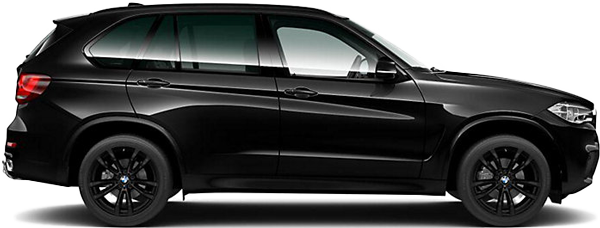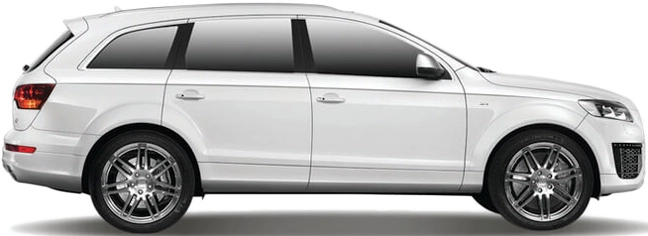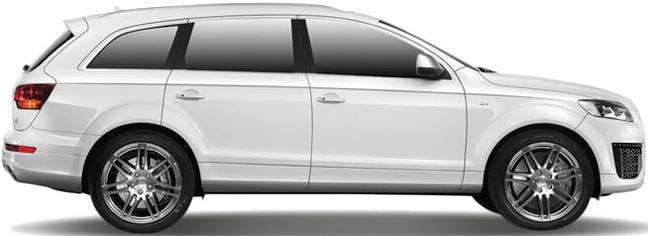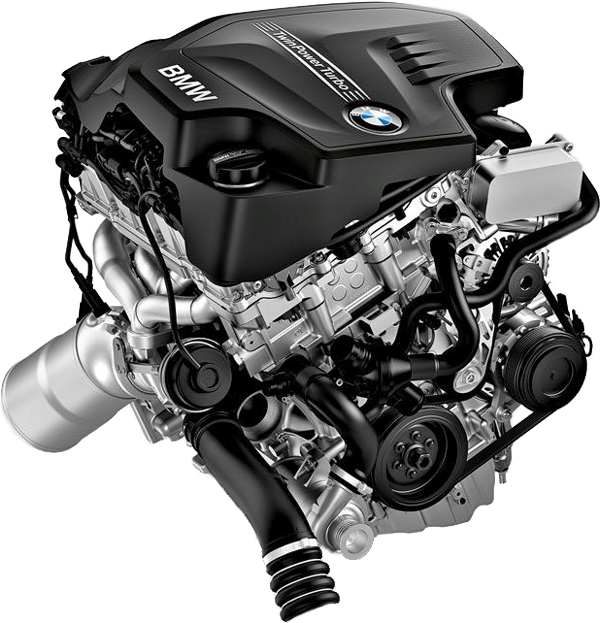Die Vergleichsanalyse :
BMW X5 xDrive40e iPerformance Steptronic (15 - 18) vs. Audi Q7 3.0 TFSI quattro tiptronic (10 - 15)
72.500 €

56.000 €

72.500 €
Grundpreis ⓘListenpreis für das Basismodell (Standardausstattung ohne Extras) zum Zeitpunkt der Markteinführung in Deutschland.
56.000 €
ⓘListenpreis für das Basismodell (Standardausstattung ohne Extras) zum Zeitpunkt der Markteinführung in Deutschland. Preisinfo
Abmessungen
Die Abmessungen dieser Fahrzeuge unterscheiden sich deutlich voneinander. Der BMW X5 xDrive40e iPerformance ist 20.3 cm kürzer, 4.5 cm schmaler und 2.5 cm höher als der Audi Q7 3.0 TFSI.
BMW X5 xDrive40e iPerformance
Audi Q7 3.0 TFSI
1762
1938
2184
1737
1983
2177
1938 mm
Breite
1983 mm
2184 mm
Breite mit Spiegeln
2177 mm
1762 mm
Höhe
1737 mm
2933
4886
3002
5089
4886 mm
Länge
5089 mm
2933 mm
Radstand
3002 mm
Gewicht
BMW X5 xDrive40e iPerformance
Audi Q7 3.0 TFSI
2305 kg
Leergewicht
2295 kg
2980 kg
Zulässiges
Gesamtgewicht
Gesamtgewicht
2945 kg

Gewichtsdifferenz:
10 kg
0.43 %

Allgemein
BMW X5 xDrive40e iPerformance
Audi Q7 3.0 TFSI
F15
Baureihe
4L
SUV (Sport Utility Vehicle)
Karosserie
SUV (Sport Utility Vehicle)
Super Plus (ROZ 98)
Kraftstoff
Super Plus (ROZ 98)

Permanenter
Allradantrieb
Allradantrieb
Antrieb
Permanenter
Allradantrieb
Allradantrieb

8-Gang-Automatikgetriebe
Getriebe
8-Gang-Automatikgetriebe
Motor
BMW X5 xDrive40e iPerformance
Audi Q7 3.0 TFSI
4-Zylinder-Plug-in-Hybrid-Benziner mit Turboaufladung
Motorbauart
V6-Benziner mit Turboaufladung
BMW N20
Motorbaureihe
N20-B20
Motorcode
CJTC, CJWC

4
Ventile
4
4
Zylinder
6
1997 cm³
Hubraum
2995 cm³
313 PS
bei 5000 U/min
Leistung
272 PS
bei 4750 U/min
BMW X5 xDrive40e iPerformance
313 PS
272 PS
Audi Q7 3.0 TFSI
350 Nm
bei 1250 U/min
Drehmoment
400 Nm
bei 2250 U/min
BMW X5 xDrive40e iPerformance
350 Nm
400 Nm
Audi Q7 3.0 TFSI
Leistungsfähigkeit
BMW X5 xDrive40e iPerformance
Audi Q7 3.0 TFSI
210 km/h
Höchstgeschwindigkeit
222 km/h
6.8 s
Beschleunigung 0 – 100 km/h
7.9 s
100 km/h
100
km/h
km/h
94 m
0.000 s

BMW X5 xDrive40e iPerformance
100 km/h
100
km/h
km/h
110 m
0.000 s

Audi Q7 3.0 TFSI
▶ REPLAY
7.36 kg/PS
Leistungsgewicht
8.44 kg/PS
BMW X5 xDrive40e iPerformance
7.36 kg/PS
8.44 kg/PS
Audi Q7 3.0 TFSI
Verbrauch / Umwelt
BMW X5 xDrive40e iPerformance
Audi Q7 3.0 TFSI
Verbrauch pro 100 km
3.3 L
kombiniert
10.7 L
BMW X5 xDrive40e iPerformance
3.3 L
10.7 L
Audi Q7 3.0 TFSI
3.3 L
innerorts
14.4 L
Кeine Daten
außerorts
Кeine Daten
85 L
Tankgröße
100 L
2576 km
Reichweite
935 km
BMW X5 xDrive40e iPerformance
2576 km
935 km
Audi Q7 3.0 TFSI
Auswirkung auf die Umwelt
38.8 kWh
Gesamtenergieverbrauch
pro 100 km ⓘDer Gesamtenergieverbrauch pro 100 km ergibt sich aus der Energie, die ein Fahrzeug bei der Verbrennung eines Treibstoffs (bzw. bei der Verwendung von Strom) pro 100 km verbraucht (Endenergie) und der Energie, die für die Erzeugung und Bereitstellung entsprechender Menge Treibstoffs (bzw. Stroms) benötigt wird (Primärenergie). Dabei werden auch die Vorprozesse der Treibstoffherstellung, der Transport eines Treibstoffs bis zur Tankstelle (bzw. der Transport des Stroms bis zur Steckdose) und die Verluste, die dabei auftreten, berücksichtigt. Der Gesamtenergieverbrauch ermöglicht somit einen Vergleich der Energieeffizienz von Fahrzeugen mit verschiedenen Antriebssystemen.
pro 100 km ⓘDer Gesamtenergieverbrauch pro 100 km ergibt sich aus der Energie, die ein Fahrzeug bei der Verbrennung eines Treibstoffs (bzw. bei der Verwendung von Strom) pro 100 km verbraucht (Endenergie) und der Energie, die für die Erzeugung und Bereitstellung entsprechender Menge Treibstoffs (bzw. Stroms) benötigt wird (Primärenergie). Dabei werden auch die Vorprozesse der Treibstoffherstellung, der Transport eines Treibstoffs bis zur Tankstelle (bzw. der Transport des Stroms bis zur Steckdose) und die Verluste, die dabei auftreten, berücksichtigt. Der Gesamtenergieverbrauch ermöglicht somit einen Vergleich der Energieeffizienz von Fahrzeugen mit verschiedenen Antriebssystemen.
126 kWh
BMW X5 xDrive40e iPerformance
38.8 kWh
126 kWh
Audi Q7 3.0 TFSI
Euro 6b (NEFZ)
Schadstoffklasse
Euro 5
77 g/km (NEFZ)
CO2-Emissionen
249 g/km (NEFZ)
Alltagsnutzen
BMW X5 xDrive40e iPerformance
Audi Q7 3.0 TFSI
5
Türen
5
5
Sitzplätze
5
675 kg
Maximale Zuladung
650 kg
500 L
Kofferraumvolumen
775 L











1720 L
Stauraum mit umgeklappter
Rücksitzbank
Rücksitzbank
2035 L






















